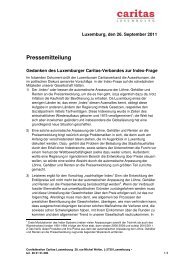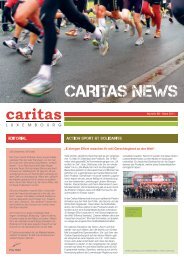Sozialalmanach - Caritas Luxembourg
Sozialalmanach - Caritas Luxembourg
Sozialalmanach - Caritas Luxembourg
Create successful ePaper yourself
Turn your PDF publications into a flip-book with our unique Google optimized e-Paper software.
8. Regime Change without the Punctuated Pendulum Swing<br />
People make history by constructing and transforming institutions that both constrain<br />
and constitute their social action. New institutions are hardly ever designed from a tabula<br />
rasa. Just as institutions shape the conduct of human actions, human conduct, in turn,<br />
reshapes institutions. Crisis management today may be critically informed by previous<br />
crisis experiences. Just as neo-liberalism did not lead to a return to the roaring Twenties<br />
of unfettered capitalism, the current crisis is equally unlikely to bring about a restoration<br />
of the post-war regime of the embedded liberalism of national political economies.<br />
Just as the current crisis is unlikely to trigger a swift pendulum swing of institutional<br />
design, it should be noted that neo-liberalism also did not attain institutional hegemony<br />
overnight. While the elections of Margaret Thatcher and Ronald Reagan may retrospectively<br />
have marked the beginning of the neo-liberal era, it was only with the fall of the Berlin Wall<br />
that this doctrine achieved global influence. The neo-liberal rise to dominance was largely<br />
evolutionary; it emerged gradually through a series of institutional transformations and<br />
policy changes over a long period of time. In contrast to the traditional belief that institutional<br />
changes are always marked by rapid changes at critical junctures, it can be expected<br />
that future institutional shifts are likely to follow the logic of incremental transformative<br />
change through institutional evolution. By comparison, the rise of embedded liberalism<br />
indeed represented a far more punctuated process of institution building.<br />
With this in mind, it is interesting to speculate about how the observed policy changes<br />
in the wake of the crisis will contribute to such a scenario of gradual institutional evolution.<br />
Specifically, five key policy changes warrant such an examination: (1) changes in<br />
central banks’ mandates and modes of operation, (2) the resurgence of international policy<br />
coordination, (3) the reappraisal of welfare policies, (4) taking climate change seriously, and<br />
(5) the search for new economic indicators that go beyond traditional measures of GDP.<br />
The crisis has pushed central banks into a broad range of new interventions, aimed at<br />
safeguarding financial stability. One intellectual lesson that has emerged from this crisis<br />
is that economists have to redefine what global and domestic financial macroeconomic<br />
stability means. Macroeconomic and financial stability is a much wider concept than price<br />
stability, and sometimes the two even conflict. Stephen Roach 47 advocates a new mandate for<br />
the Federal Reserve; it should lean against the winds of financial excess and asset bubbles.<br />
Similarly, Willem Buiter, Paul De Grauwe, and Barry Eichengreen 48 all argue that the<br />
ECB will in the near future be required to perform a variety of new functions, including<br />
undertaking liquidity and credit enhancing measures, becoming a lender of last resort, and<br />
47 Roach (2009).<br />
48 Buiter (2008); Grauwe, De (2008); Eichengreen (2009).<br />
177








